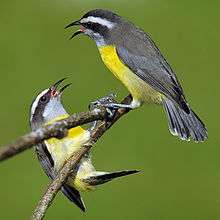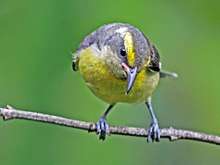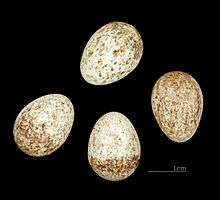Bananaquit
The bananaquit (Coereba flaveola) is a species of passerine bird of uncertain relation. It is tentatively placed in the tanager family. Its classification is debated, and it is often placed in its own family: Coerebidae. It has been suggested that some races of the bananaquit exhibit enough genetic difference to warrant species status,[2] but this has yet to receive widespread recognition. This small, active nectarivore is found in warmer parts of the Americas, and is generally common.
| Bananaquit | |
|---|---|
 | |
| Scientific classification | |
| Kingdom: | Animalia |
| Phylum: | Chordata |
| Class: | Aves |
| Order: | Passeriformes |
| Family: | Thraupidae |
| Genus: | Coereba Vieillot, 1809 |
| Species: | C. flaveola |
| Binomial name | |
| Coereba flaveola | |
 | |
| Synonyms | |
| |
Taxonomy
The bananaquit was first described by Carl Linnaeus in his landmark 1758 10th edition of Systema Naturae as Certhia flaveola.[3] It was reclassified as the only member of the genus Coereba by Louis Jean Pierre Vieillot in 1809.[4] Prior to 2005, the bananaquit was assigned to the monotypic family Coerebidae; there is currently no agreement to which family it belongs; some authors place it into the Emberizidae.[5] Since recent studies have shed some light on the bananaquit's affinities, many authorities consider Coerebidae an obsolete taxon. The Coerebidae used to contain other nectar-eating birds from the tropical Americas, but these have since been moved. The bananaquit is part of a group that includes Darwin's finches, Tiaris (grassquits), Loxigilla, etc.—most of which were previously placed in Emberizidae, but are now known to actually be part of the Thraupidae.[6] As such this species is tentatively placed in the family Thraupidae unless a study suggests more accurate placement. Nevertheless, its precise relations remain unresolved, so the American Ornithologists' Union classes it as a species incertae sedis.[7]
It is still unclear if any of the island subspecies should be elevated to species, but phylogenetic studies have revealed three clades: the nominate group from Jamaica, Hispaniola and the Cayman Islands, the bahamensis group from the Bahamas and Quintana Roo, and the bartholemica group from South and Central America, Mexico (except Quintana Roo), the Lesser Antilles and Puerto Rico.[8][9] Several taxa were not sampled,[8][9] but most of these are easily placed in the above groups based on zoogeography alone. Exceptions are oblita (San Andrés Island) and tricolor (Providencia Island), and their placement is therefore uncertain. In February 2010, the International Ornithological Congress listed bahamensis and bartholemica as proposed splits from C. flaveola.[10]
Subspecies
There are 41 currently recognized subspecies:[11]
- C. f. bahamensis (Reichenbach, 1853): Bahamas
- C. f. caboti (Baird, 1873): east Yucatan Peninsula and nearby islands
- C. f. flaveola (Linnaeus, 1758): nominate, Jamaica
- C. f. sharpei (Cory, 1886): Cayman Is.
- C. f. bananivora (Gmelin, 1789): Hispaniola and nearby islands
- C. f. nectarea Wetmore, 1929: Tortue I.
- C. f. portoricensis (Bryant, 1866): Puerto Rico
- C. f. sanctithomae (Sundevall, 1869): north Virgin Is.
- C. f. newtoni (Baird, 1873): Saint Croix (south Virgin Is.)
- C. f. bartholemica (Sparrman, 1788): north and central Lesser Antilles
- C. f. martinicana (Reichenbach, 1853): Martinique and Saint Lucia (south central Lesser Antilles)
- C. f. barbadensis (Baird, 1873): Barbados
- C. f. atrata (Lawrence, 1878): St. Vincent (south Lesser Antilles)
- C. f. aterrima (Lesson, 1830): Grenada and the Grenadines (south Lesser Antilles)
- C. f. uropygialis von Berlepsch, 1892: Aruba and Curaçao (Netherlands Antilles)
- C. f. tricolor (Ridgway, 1884): Providencia I. (off east Nicaragua)
- C. f. oblita Griscom, 1923: San Andrés I. (off east Nicaragua)
- C. f. mexicana (Sclater, 1857): southeastern Mexico to western Panama
- C. f. cerinoclunis Bangs, 1901: Pearl Is. (south of Panama)
- C. f. columbiana (Cabanis, 1866): eastern Panama to southwestern Colombia and southern Venezuela
- C. f. bonairensis Voous, 1955: Bonaire I. (Netherlands Antilles)
- C. f. melanornis Phelps & Phelps, 1954: Cayo Sal I. (off Venezuela)
- C. f. lowii Cory, 1909: Los Roques Is. (off Venezuela)
- C. f. ferryi Cory, 1909: La Tortuga I. (off Venezuela)
- C. f. frailensis Phelps & Phelps, 1946: Los Frailes and Los Hermanos Is. (off Venezuela)
- C. f. laurae Lowe, 1908: Los Testigos (off Venezuela)
- C. f. luteola (Cabanis, 1850): coastal northern Colombia and Venezuela, Trinidad and Tobago
- C. f. obscura Cory, 1913: northeastern Colombia and western Venezuela
- C. f. minima (Bonaparte, 1854): eastern Colombia and southern Venezuela to French Guiana and north central Brazil
- C. f. montana Lowe, 1912: Andes of northwestern Venezuela
- C. f. caucae Chapman, 1914: western Colombia
- C. f. gorgonae Thayer & Bangs, 1905: Gorgona I. (off western Colombia)
- C. f. intermedia (Salvadori & Festa, 1899): southwestern Colombia, western Ecuador and northern Peru east to southern Venezuela and western Brazil
- C. f. bolivari Zimmer & Phelps, 1946: eastern Venezuela
- C. f. guianensis (Cabanis, 1850): southeastern Venezuela to Guyana
- C. f. roraimae Chapman, 1929: tepui regions of southeastern Venezuela, southwestern Guyana and northern Brazil
- C. f. pacifica Lowe, 1912: eastern Peru
- C. f. magnirostris (Taczanowski, 1880): northern Peru
- C. f. dispar Zimmer, 1942: north central Peru to western Bolivia
- C. f. chloropyga (Cabanis, 1850): east central Peru to central Bolivia and east to eastern Brazil, northern Uruguay, northeastern Argentina and Paraguay
- C. f. alleni Lowe, 1912: eastern Bolivia to central Brazil
Subspecies gallery
.jpg) C. f. aterrima ("normal" and dark morph), Grenada
C. f. aterrima ("normal" and dark morph), Grenada.jpg) C. f. bahamensis, Bahamas
C. f. bahamensis, Bahamas.jpg) C. f. bartholemica, Guadeloupe
C. f. bartholemica, Guadeloupe_(8).jpg) C. f. chloropyga, São Paulo, Brazil
C. f. chloropyga, São Paulo, Brazil C. f. flaveola, Jamaica
C. f. flaveola, Jamaica.jpg) C. f. luteola, Trinidad
C. f. luteola, Trinidad.jpg) C. f. mexicana, Costa Rica
C. f. mexicana, Costa Rica C. f. portoricensis, Puerto Rico
C. f. portoricensis, Puerto Rico C. f. sanctithomae, Saint John, U.S. Virgin Islands
C. f. sanctithomae, Saint John, U.S. Virgin Islands
Description

The bananaquit is a small bird, although there is some degree of size variation across the various subspecies. Length can range from 4 to 5 in (10 to 13 cm).[12][13] Weight ranges from 5.5 to 19 g (0.19 to 0.67 oz).[14][15]
Most subspecies of the bananaquit have dark grey (almost black) upperparts, black crown and sides of the head, a prominent white eyestripe, grey throat, white vent, and yellow chest, belly and rump.
The sexes are alike, but juveniles are duller and often have a partially yellow eyebrow and throat.
In the subspecies bahamensis and caboti from the Bahamas and Cozumel, respectively, the throat and upper chest are white or very pale grey,[16][17] while ferryi from La Tortuga Island has a white forehead.[18] The subspecies laurae, lowii and melanornis from small islands off northern Venezuela are overall blackish,[18] while the subspecies aterrima and atrata from Grenada and Saint Vincent have two plumage morphs, one "normal" and another blackish.[16] The pink gape is usually very prominent in the subspecies from islands in the Caribbean Sea.
Behaviour


The bananaquit has a slender, curved bill, adapted to taking nectar from flowers. It sometimes pierces flowers from the side, taking the nectar without pollinating the plant.[19] It also feeds on sweet juices by puncturing fruit with its beak, and will eat small insects on occasion. While feeding, the bananaquit must always perch as it cannot hover like a hummingbird.[20]
The bananaquit is known for its ability to adjust remarkably to human environments. It often visits gardens and may become very tame. Its nickname, the sugar bird, comes from its affinity for bowls or bird feeders stocked with granular sugar, a common method of attracting these birds.[20] The bananaquit builds a spherical lined nest with a side entrance hole, laying up to three eggs, which are incubated solely by the female.[5] It may also build its nest in human-made objects, such as lampshades and garden trellises. The birds breed all year regardless of season and build new nests throughout the year.[20]
Distribution
It is resident in tropical South America north to southern Mexico and the Caribbean. It is found throughout the West Indies, except for Cuba.[16] Birds from the Bahamas are rare visitors to Florida.[19]
It occurs in a wide range of open to semi-open habitats, including gardens and parks, but it is rare or absent in deserts, dense forests (e.g. large parts of the Amazon rainforest) and at altitudes above 2,000 m (6,600 ft).[18]
References
- BirdLife International 2012
- "Bananaquit (Coereba flaveola)". www.hbw.com. Retrieved 2020-04-22.
- Linnaeus 1758, p. 119
- Vieillot 1809, p. 70
- Monteiro Pereira 2008, p. 120
- Burns, Hackett & Klein 2002
- American Ornithologists' Union 2008
- Seutin et al. 1994
- Bellemain, Bermingham & Ricklefs 2008
- "Updates: Candidates". IOC World Bird List. Archived from the original on June 18, 2010. Retrieved 21 October 2011.
- Gill, F.; Donsker, D., eds. (2014). "Bananaquit, buntings, sparrows & bush tanagers". IOC World Bird List (v 4.2). doi:10.14344/IOC.ML.4.2. Archived from the original on 26 July 2014. Retrieved 26 July 2014.
- "Bananaquit". anywherecostarica.com. Retrieved 21 October 2011.
- "Bananaquit". enature.com. Retrieved 21 October 2011.
- "Bananaquits". birdingguide.com. Archived from the original on 18 November 2011. Retrieved 21 October 2011.
- Diamond 1973
- Raffaele et al. 1998
- Howell & Webb 1995
- Restall, Rodner & Lentino 2006
- Dunning 2001
- De Boer 1993, p. 105
Literature cited
- American Ornithologists' Union (2008). "Check-list of North American Birds". Retrieved 5 January 2009.CS1 maint: ref=harv (link)
- Bellemain, Eva; Bermingham, Eldredge; Ricklefs, Robert E. (2008). "The dynamic evolutionary history of the bananaquit (Coereba flaveola) in the Caribbean revealed by a multigene analysis". BMC Evolutionary Biology. 8: 240. doi:10.1186/1471-2148-8-240. PMC 2533019. PMID 18718030.CS1 maint: ref=harv (link)
- BirdLife International (2012). "Coereba flaveola". IUCN Red List of Threatened Species. 2012. Retrieved 26 November 2013.CS1 maint: ref=harv (link)
- Burns, K. J.; Hackett, S. J.; Klein, N. K. (2002). "Phylogenetic relationships and morphological diversity in Darwin's finches and their relatives" (PDF). Evolution. 56 (6): 1240–1252. doi:10.1111/j.0014-3820.2002.tb01435.x. PMID 12144023.CS1 maint: ref=harv (link)
- Diamond, A. W. (1973). "Altitudinal variation in a resident and migrant passerine on Jamaica" (PDF). The Auk. 90 (3): 610–618. doi:10.2307/4084159. JSTOR 4084159.CS1 maint: ref=harv (link)
- Dunning, John B. Jr (2001). "Bananaquit". In Elphick, Chris; Dunning, John B. Jr.; Sibley, David Allen (eds.). The Sibley Guide to Bird Life and Behavior. New York: Alfred A. Knopf. pp. 510–511. ISBN 978-1-4000-4386-6.CS1 maint: ref=harv (link)
- Howell, S. N. G.; Webb, S. (1995). A Guide to the Birds of Mexico and Northern Central America. London: Oxford University Press. ISBN 0-19-854012-4.CS1 maint: ref=harv (link)
- Linnaeus, C. (1758). Systema naturae per regna tria naturae, secundum classes, ordines, genera, species, cum characteribus, differentiis, synonymis, locis. Tomus I. Editio decima, reformata (in Latin). Stockholm: Laurentius Salvius.
C. nigra, uropygio pectoreque luteo, superciliis macula alarum rectricumque apicibus albis.
CS1 maint: ref=harv (link) - Monteiro Pereira, José Felipe (2008). Aves e Pássaros Comuns do Rio de Janeiro [Common Birds of Rio de Janeiro] (in Portuguese). Rio de Janeiro: Technical Books. ISBN 978-85-61368-00-5.CS1 maint: ref=harv (link)
- De Boer, Bart A. (1993). Our Birds. Willemstad: Stichting Dierenbescherming Curaçao. ISBN 978-99904-0-077-9.CS1 maint: ref=harv (link)
- Raffaele, Herbert; Wiley, James; Garrido, Orlando; Keith, Allan; Raffaele, Janis (1998). A Guide to the Birds of the West Indies. Princeton: Princeton University Press. ISBN 978-0-691-08736-8.CS1 maint: ref=harv (link)
- Restall, R. L.; Rodner, C.; Lentino, M. (2006). Birds of Northern South America – An Identification Guide. London: Christopher Helm. ISBN 0-7136-7242-0.CS1 maint: ref=harv (link)
- Seutin, G; Klein, N. K.; Ricklefs, R. E.; Bermingham, E. (1994). "Historical biogeography of the bananaquit (Coereba flaveola) in the Caribbean region: a mitochondrial DNA assessment". Evolution. 48 (4): 1041–1061. doi:10.2307/2410365. JSTOR 2410365.CS1 maint: ref=harv (link)
- Vieillot, Louis Jean Pierre (1809). Histoire naturelle des oiseaux de l'Amérique septentrionale [Natural History of the Birds of Northern America] (in French). Paris: Desray.CS1 maint: ref=harv (link)
External links
| Wikimedia Commons has media related to Coereba flaveola. |
| Wikispecies has information related to Coereba flaveola |
- "Bananaquit media". Internet Bird Collection.
- Bananaquit Stamps (with range map) at bird-stamps.org
- Audio recordings of the Bananaquit on Xeno-canto.
- Bananaquit photo gallery at VIREO (Drexel University)
- Bananaquit species account at Neotropical Birds (Cornell Lab of Ornithology)
- Interactive range map of Coereba flaveola at IUCN Red List maps
